How to Tell if a Watermelon is Ripe (Find the Best Melon!)
This post may contain affiliate links. Read my full disclosure here.
Whether a watermelon is sweet depends the grower and Mother Nature, as well as proper storage. These tips will show you how to tell if a watermelon is ripe and ready to pick from the vine. PLUS – I’ll tell you how to store a watermelon for best flavor and nutrition.
Table of Contents
How to Tell if a Watermelon is Ripe
Some of these tips will help you tell when a watermelon is ripe on the vine. Others apply to both picking or buying watermelons at the grocery store or farmers market.
Ripe watermelons are a little trickier to identify than muskmelons. Muskmelons slip right off the vine (i.e. come loose on their own) when ripe. Watermelons don’t fall off the vine when ripe.
#1 – Check the Field Spot on the Underside of the Watermelon
The underside of the watermelon where it touched the ground should be buttery yellow to dark yellow in color. This is called the field patch or field spot.
If the field spot as pasty white as a bald guy’s head in the middle of a Wisconsin winter, it’s an underripe or unripe watermelon.
Different growing conditions and different types of melons will produce a range of colors (inside and out). Warmer weather usually yields a darker field spot.
Sometimes you may also see sugar spots, small black spots, often near the blossom end, where sap has leaked. We don’t commonly get these in our northern garden.
#2 – Check the Sound to See if a Watermelon is Ripe
This is a classic way to pick a good watermelon. The internet is filled with descriptions of how a ripe watermelon should sound. Most say “flat” or “dull”, but I think that’s a poor description.
A ripe watermelon should have a nice, deep hollow sound, more like a drum or knocking on a door. I did a quick video (below), knocking on a melon that looks promising.
#3 – If you want a ripe watermelon, make sure it is fully grown
This is for those trying to figure out how to tell if a watermelon growing in the garden is ripe. Days to maturity will give you a rough estimate of expected watermelon ripening time.
When a watermelon is well filled out and isn’t changing in size, it’s time to looks for signs of ripeness. The rind of the melon will get darker and duller when it reaches full growth. Young melons look more shiny.

#4 – Check the Little Curling Tendril Located Where the Watermelon Stem Joins the Main Vine
This is another tip for checking ripe watermelons in the garden. Right where the stem to your melon joins the main vine, there should be a little curling tendril of vine. If the tendril is still green and springy, the melon is still growing.
If this little tendril is brown and dried, odds are your melon is as ripe as it’s going to get. Sometimes all your vines may start dying back before you’ve harvested, not just a tendril. Ready or not, your watermelons are done growing.
Also, if it’s been dry, sometimes the tendrils will dry back prematurely, so check the other signs first.
#5 – Poke Your Blossom End
Jerry, one of our readers, shares his experience:
I mostly agree with the methods mentioned in this article.
My dad grew watermelons for many years in Florida so he had the advantage of following the fruit’s development to complete ripeness. I have passed his knowledge on to many friends who confirm his method of ripeness selection.
Because so much depends on soil fertility and irrigation/rainfall sweetness is hard to determine. However, determining RIPENESS is a fairly full proof method. Thumping a melon doesn’t mean much at all regarding sugar content.
In fact, the only indicator a consumer has in the market for determining the melon’s RIPENESS is by pressing on the blossom end of the water melon to see how much “give” it has. The blossom end is opposite the stem end.
If it is ripe there will be some give when pressed with the thumb. If it’s not ripe it will be hard as a rock. A watermelon that’s TOO ripe it will give little resistance, and likely be “mealy” inside.
It’s always worked for me, for what it’s worth.
How to Store Watermelon
Melons like to be stored warm. Storing watermelons at room temperature also makes them more nutritious.
From the article “Watermelon Fruit nutritional value health benefit” by Ray Sahelian, M.D.:
Watermelons stored at room temperature deliver more nutrients than refrigerated or freshly picked melons.
Researchers tested several popular varieties of watermelon stored for 14 days at 70 °F, 55 °F and 41 °F. Whole watermelons stored at 70 °F, which is about room temperature in air conditioned buildings, had substantially more nutrients.
Compared with freshly picked fruit, watermelon stored at 70 °F gained up to 40 percent more lycopene and 50 percent to 139 percent extra beta-carotene, which the body converts to vitamin A. Watermelons continue to produce these nutrients after they are picked and that chilling slows this process.
The usual shelf life for watermelons is 14 to 21 days at 13 °C (55 °F) after harvest. At refrigerated temperatures, such as 41 °F, watermelon starts to decay and develop lesions after a week.
Do not store your melon in the refrigerator until it’s cut (or chill only briefly right before serving). Once it’s cut and refrigerated, eat it up ASAP.
When we do our final melon harvest in fall when frost threatens, I aim to pick them after several dry days. Picking a watermelon right after heavy rain or in wet conditions will reduce storage life.
I store our watermelons in open cardboard boxes in the basement, which has a temperature of around 70°F. We make sure there’s good air flow around the melons. The boxes stay open so we can easily visually inspect them for any signs of spoilage.
As our garden soil has improved, so has the storage life of our melons. We are now able to store home grown watermelons for months after harvest, not weeks.
Would you like to save this?
Tips from “An Experienced Farmer” on How to Pick a Good Watermelon
There are “tips from an experienced farmer” circulating online about how to pick a good watermelon.
Some of these are valid, some of them are flat out wrong. I suspect that the information was made up as a way to sell round watermelons with marks on them. I’ll review these “tips” (listed in italics) to let you know what’s right and what’s wrong.
#1 – Look for the Field Spot
The yellow spot, known as the field spot, is the place where the watermelon rested on the ground. Ripe watermelons always have creamy yellow or even orange-yellow spots, not white. – CORRECT, as noted above
#2 – Look for ‘webbing’
These weblike brown spots on the watermelon mean that bees touched the pollinating parts of the flower many times. The more pollination, the sweeter the fruit is. – WRONG
As noted by Texas A&M Agrilife Extension Plant Disease Handbook:
“Cracks, scarring, and pitting can be caused by mechanical damage when vegetables are young, Insects can also cause such injury. Animals, such as wild hogs and racoons, can cause more substantial damage.”
In my experience, heavy exterior scarring often leads to tough or woody areas inside the fruit. (Mild scarring is not a problem.) More scars does not mean a sweeter watermelon.
#3 – ‘Boy’ and ‘Girl’ Watermelons
Many people do not know that farmers differentiate watermelons by gender. For example, ’boys’ are bigger, have an elongated shape, and a watery taste. The ’girls’ have a rounded shape and are very sweet. – WRONG
All watermelons come from female flowers, which have a small swelling at the base of the flower. There are no male watermelons. The shape of the watermelon is determined by the variety of watermelon.
A round watermelon is not necessarily a better watermelon. Both melons pictured below were good, but the so-called “male watermelon” (the longer one) was sweeter then the round one.
#4 – Pay Attention to the Size
It is better to choose neither the largest nor the smallest watermelon. Select an average sized fruit. And note, please: large or small, the watermelon should feel heavy for its size. – SIZE DOESN’T MATTER
If you’re shopping at the grocery store, and you’ll typically find that the melons are all similar in size. In the garden, you want to look for large fruit that are fully grown.
If you start lifting watermelons, I bet in most cases you’ll find that their weights are similar as well. Grocery stores like uniform produce.
#5 – Inspect the Tail
A dried tail indicates that the watermelon is ripe. However, if the tail is green, it probably means that the watermelon was picked too soon and will not be ripe. – MAYBE
As noted above, it’s the tendril next to the watermelon on the vine that acts as a ripeness indicator. The vine itself may or may not indicate ripeness.
A brown stem in a grocery store could mean the melon sat around after harvest. It could also mean that the plant was dying when the watermelon was harvested. You have no way to know for sure.
Good Watermelons for Northern Growers
Growing watermelons with a short growing season can be a challenge, but with extra care we manage a good harvest. Some of our favorite watermelon varieties include:
- Orangeglo
- Blacktail Mountain
- Chelsea
- Yellow Petite
- Crimson Sweet
Even though Orangeglo and Yellow Petite don’t get red, the same rules still apply for determining if they are ripe. Sugar Babies are another popular variety for home gardeners, but we prefer the flavor of these varieties.
Here’s one of my favorite watermelon photos from a few years ago.
Unlike some fruits, watermelons do not continue to ripen once they are off the vine. Choose carefully, and store watermelons the right way to keep them flavorful.
Can you tell if a watermelon is ripe by smell? Nope. Uncut watermelons are less fragrant than muskmelons, because they don’t have that open end where the vine was formerly attached.
You will never find me sniff testing watermelons in the grocery store, but you may find me sniffing cantaloupes.
Thank you for reading! We love your shares and comments. Did I miss any tips that you use to pick a good watermelon? Leave a comment and share your thoughts.
You may also enjoy:
Originally posted in 2014, last updated in 2022.

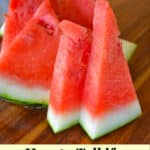
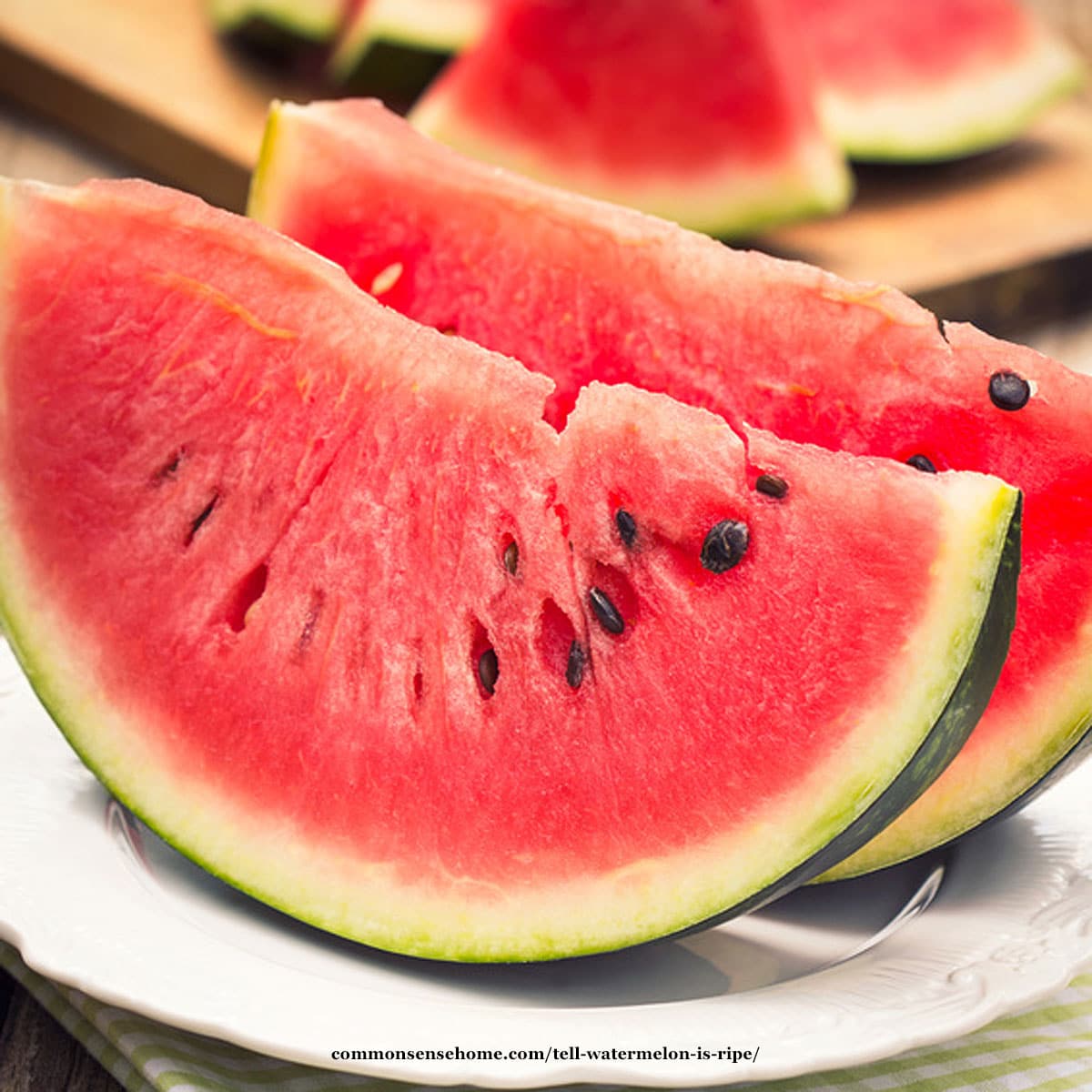
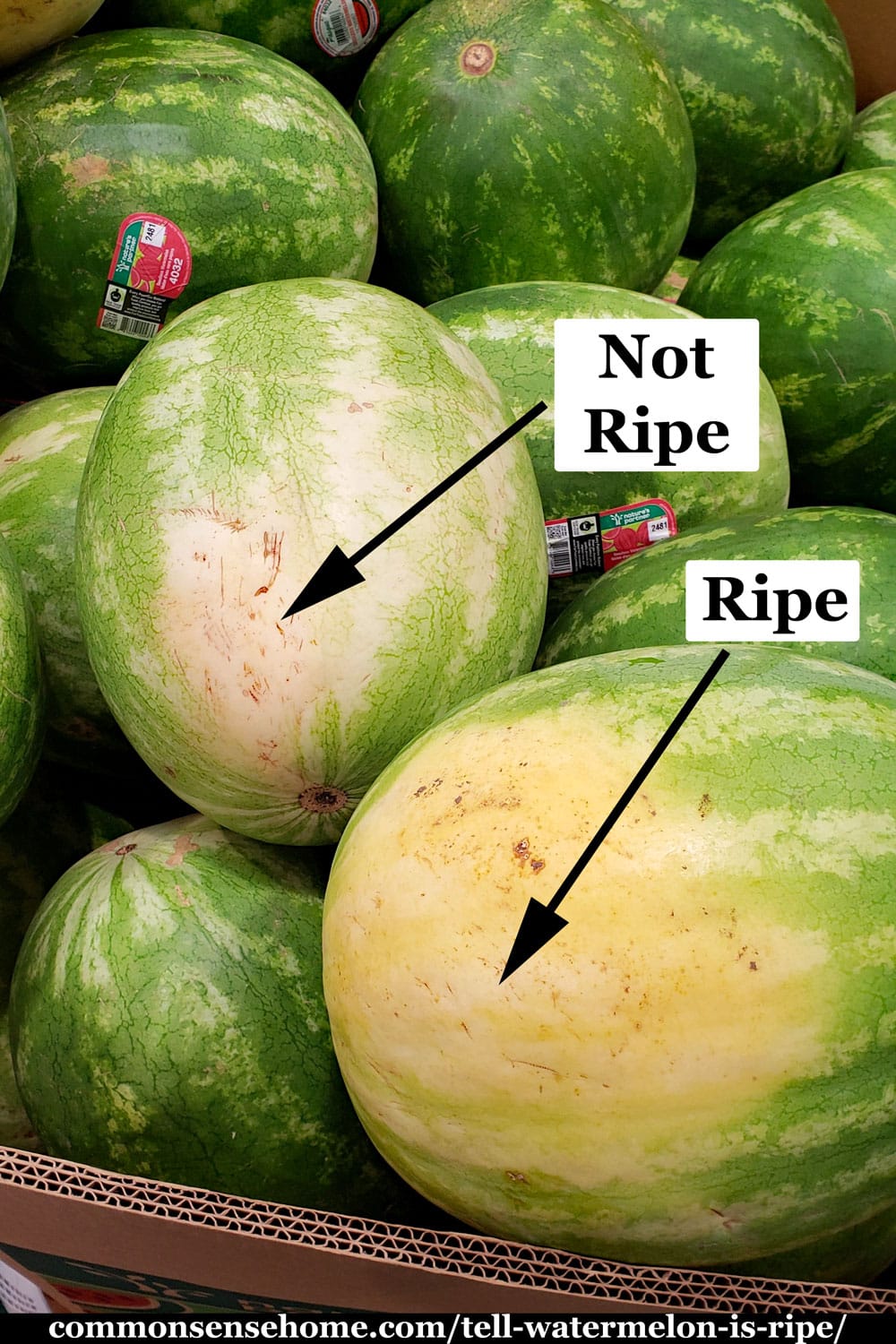

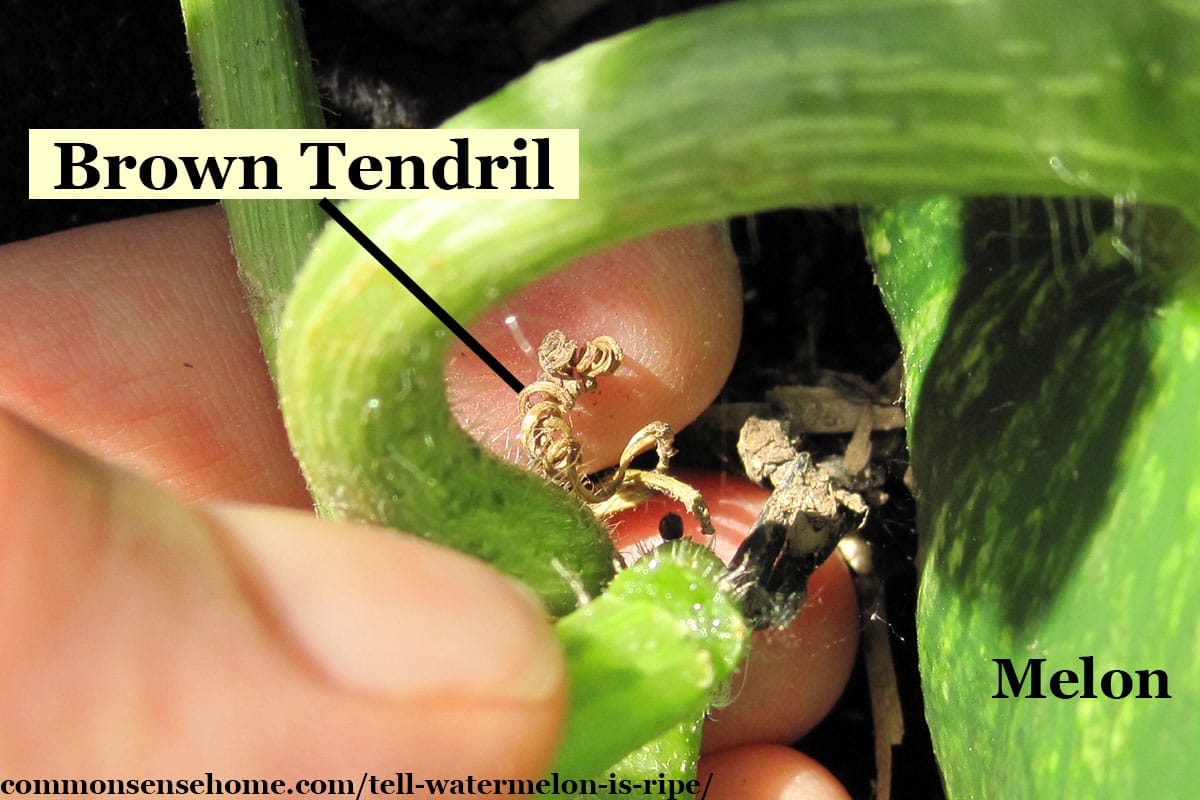
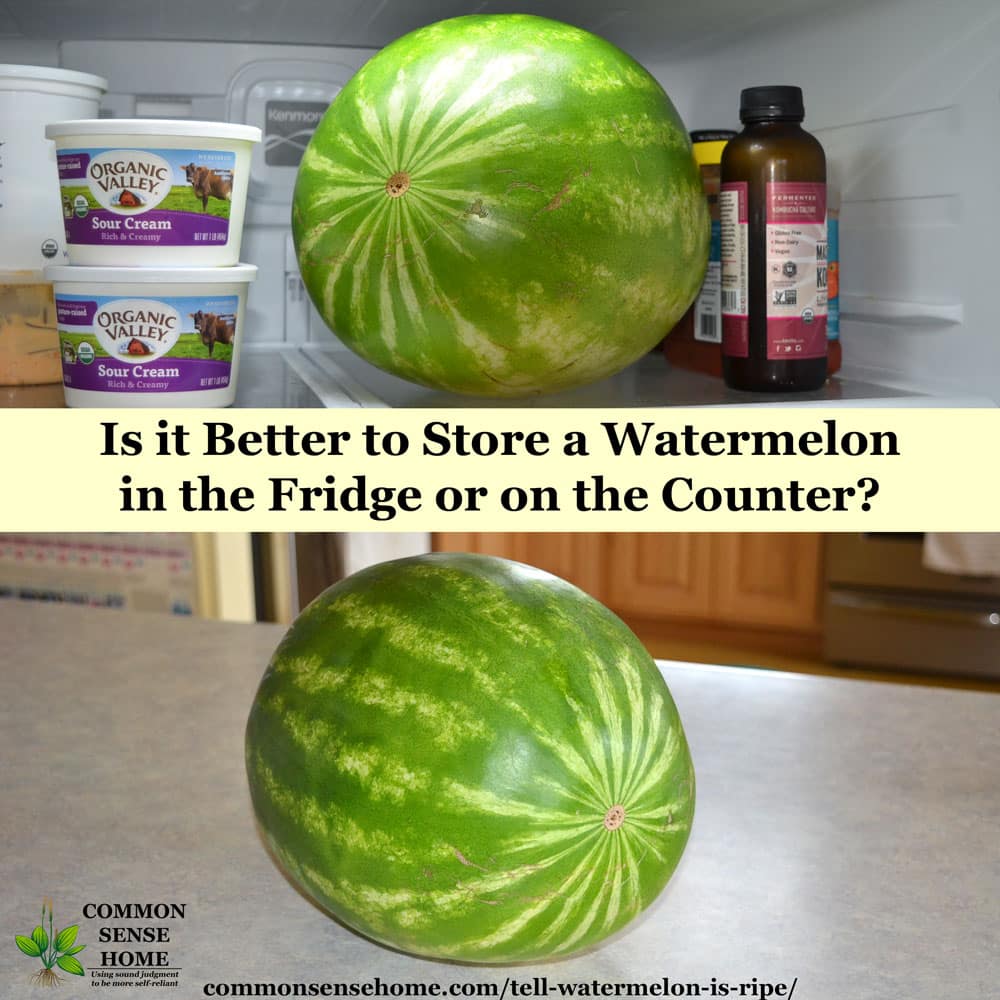

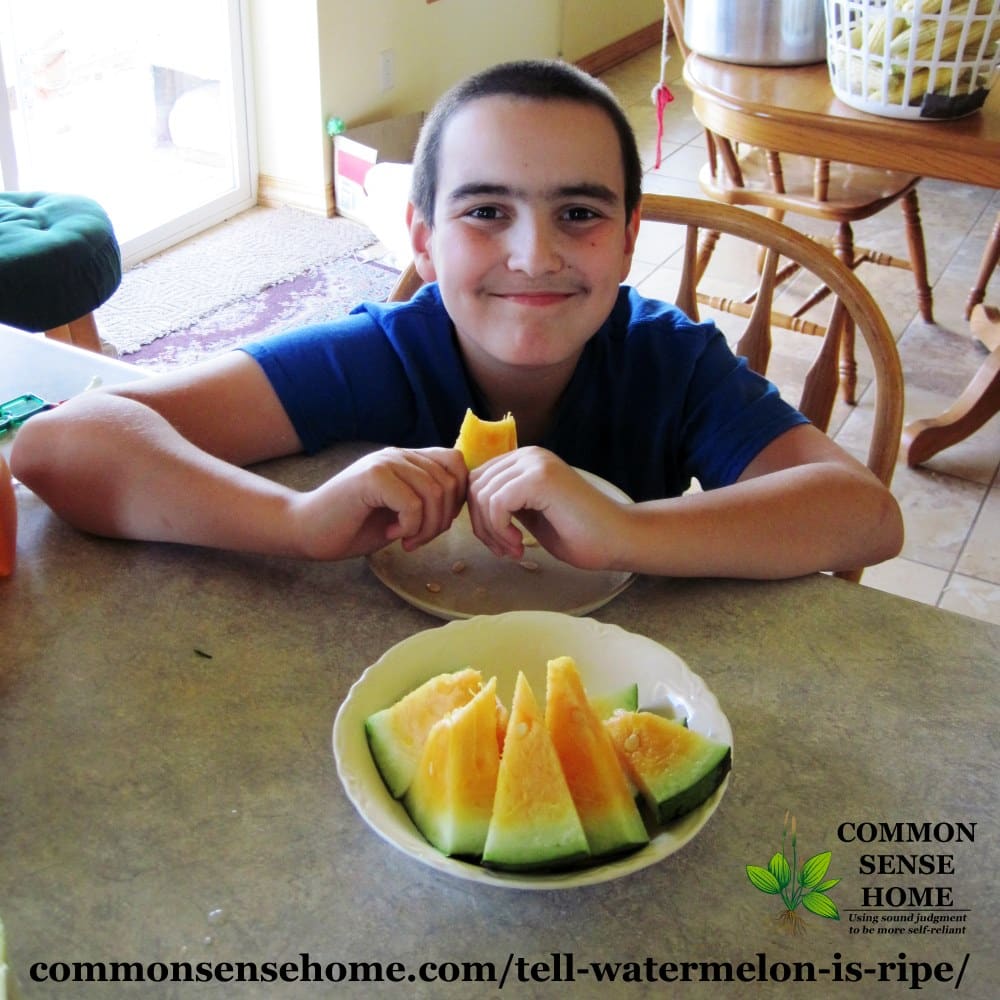

A really good melon for colder parts of the country is Dakota Rose. They are a striped melon and Grow to 30 lbs for me here in upstate NY. Very sweet and a frosty rose color inside
That’s not one that I have tried. Thank you for the suggestion, Betty.
I do have to say I did not have a single melon this year that was 30 lbs. But it has happened in past years. They are a striped watermelon, I bought them from Fedco seeds.
I think the biggest we’ve ever had were around 20 pounds, but this year none were even close to that.
Thank you for such informative tips. It is my first time to grow watermelons, and I am growing little Kaho watermelons in 20″ pots with a supporting trellis. I have my first melon, and believed it might be ready to pick. After reading your comments, I can see that there is ample reason to be patient and wait. Hard on the bottom blossom end, green tendril (even with 100 degree Texas heat), and yet it seems like it is full and no longer growing. So I shall keep a watchful eye on it and give it more time. Thanks again for sharing your experience and wisdom.
It sounds like it may have reached full size, so now it just needs some time to sweeten up. Almost there!
I mostly agree with the methods mentioned in this article. My dad grew watermelons for many years in Florida so he had the advantage of following the fruit’s development to complete ripeness. I have passed his knowledge on to many friends who confirm his method of ripeness selection. Because so much depends on soil fertility and irrigation/rainfall sweetness is hard to determine. However, determining RIPENESS is a fairly full proof method. Thumping a melon doesn’t mean much at all regarding sugar content. In fact, the only indicator a consumer has in the market for determining the melon’s RIPENESS is by pressing on the blossom end of the water melon to see how much “give” it has. The blossom end is opposite the stem end. If it is ripe there will be some give when pressed with the thumb. If it’s not ripe it will be hard as a rock. If it’s TOO ripe it will give little resistance and likely be “mealy” inside.
It’s always worked for me. for what it’s worth.
Thanks for sharing your watermelon picking experience, Jerry. Given the distance many of our melons travel here in Wisconsin, I don’t know if your technique will be as helpful here as it would be closer to fresh melons, but I’m going to test it out next time I’m poking through the bins.
Ripe Watermelon?
All of this suggestions or way to know are: a mistake, ignorance or a lie.
The only way to know if a watermelon is ripe or not… is looking for CRUSTS in the skin.
ONLY RIPE WATERMELONS HAVE CRUSTS IN THE SKIN!!!
Sergio – have you ever grown watermelons? I have – for years. You are mistaken.
Laurie – I stumbled across this conversation while inquiring about watermelon ripeness, etc. Kudos to you for a polite, albeit necessary, correction.
Thank you, Frederick. I’m a bit of a melon snob after the years of picking them out for catering, and all the wrong information circulating around was driving me buggy.
My husband asked his melon farming uncle how to tell when one is ripe. After getting a long look that said he surely was from another planet, he said to check for the deepest grooves between the green stripes. Reasoning is that it will sweeten up when it draws from the rind’s moisture, causing ridges & valleys. (Read: don’t water them as their ripening date arrives) Overwatered melons will remain bland for that reason.
You can also tell if a watermelon is ripe by placing a dry straw perpendicular to the melon and watching how fast it will align with the melon. The more ripe (water) the faster it will move in alignment with the melon. You can find a straw from the broom section of the store. Just pull a dry straw out of the broom and go to the melon section. Put the melon in your basket or on floor so that it sits still without you touching it. Place the straw in the middle of the melon perpendicular to the melon (it will form a plus sign with the melon). Let go of straw and just watch with amazement!!! You will have everyone in the produce section running to the broom dept wanting to try for themselves!!! My grandpa used to pick a watermelon from the garden like this when we were kids! I swear it works!!!
Nice writeup about watermelons… I have a comment about your short video: Sure, nice sound, but it would help if you could add a one or two UNRIPE melons to COMPARE the sound… yeah, we can describe the sounds in so many ways.. but there is nothing like HEARING IT. That is why I like your video… Just saying there: ” Here is the RIPE SOUND: ##### and here is the UNRIPE SOUND #~~~~~… and here is the RIPE SOUND again ###…” LOL ok?!
Good article, btw, thanks.
Zed.
What I need now is real audio recording equipment to get the full sound comparison.
I have never had luck growing watermelons. However, this year a vine sprouted up next to my porch. Best guess is the kids spit seeds over the rail. We have harvested 6 melons from this impromptu vine and there is currently 5 more on there!!
Plants know where they want to grow. 🙂
Awesome tips. Am wondering though, if you end up with an unripe melon and it’s been cut is there anyway to help rippen it then?
Unfortunately, unlike cantaloupe, watermelons will not ripen further once they are off the vine.
One tip doesn’t work for me due to another trick I learned some time ago. Since watermelons DO have those gripping tendrils all over the vines, and do in fact grow on vines, if given a trellis to grow on your melons never touch the ground and don’t get that yellow spot on one side. They are also less prone to be attacked by ground crawling critters and they are much more uniform in shape.
a few of my sugar babies have brown tendrils but no change of color underneath. what do ya think?
There’s really no way for me to tell for sure long distance. Sometimes the tendrils start dying back a little early if it’s been hot and/or dry. Check your days to maturity and planting date, and see if the timing is right, give it a thunk take your best guess.
Just what is average days for watermelons and cantaloupe. Mine look big and ready but no yellow where it laid
Some varieties don’t develop a field spot. Average days to maturity for watermelons is quite different, depending on the variety, ranging from around 80 days for some of the smaller types to over 100 days for the big southern melons. Cantaloupe should slip off the vine (easily release) when ripe. They will also likely be very fragrant where the vine attaches to the melon.
hi i am wondering about the lenth of time watermelons are planted i plantedthese may 15 i picked the biggest one today before i read your advice cut it open it was pink and was not out to the rind very good these are crimson sweet and had no taste
A quick search shows Crimson Sweet with a Fruit Weight of 25-35 pounds and Days to Maturity = 80 days, so you should be getting close, but the weather can slow ripening down quite a bit. If you didn’t have pink all the way to the rind, give it at least another week or two before you try picking the next one, and check for the signs of ripeness.
This post was helpful, as we just picked one (of many) Crimson Sweet and it was not quite pink to the rind and not much flavor. Our tendrils were brown, but the bottoms were not really yellow, so looks like we need to make sure to follow all 4 steps…..
Your tips are more comprehensive than any I’ve seen yet!!! Great site!
Has it been dry, by any chance? That can cause the tendrils to brown up prematurely. (I should add that to the post…)
Glad you like the site. I try to write the type of article that I want to read.
I was talking to an “old geezer” (that’s what he called himself) about finding a ripe watermelon and he showed me the straw check. He went into the back room, pulled out a piece of dry broom straw and set it on top of the watermelon. If the watermelon is ripe, the straw actually swings around and lines up with the ends of the watermelon. NO KIDDING! I was flabbergasted. It worked…and it’s a good party trick!
I’ve never heard of such a thing. I may have to try that. 🙂
how do I can cabbage I don’t want anything but plain cabbage
Canning cabbage is not recommended by the USDA because it is a low acid food that may heat unevenly in the jars, leasing to botulism concerns. I usually keep mine in the root cellar for a while, and then freeze or pickle anything that we haven’t eaten when it starts to get soft. Crystal at Homemaking on the Homestead did share instructions for how she pressure cans cabbage for her family. Use at your own risk. Under no circumstances do I recommend water bath canning plain cabbage.
Randy I have canned plain cabbage for several years and it is delicious. Most canning books don’t recommend it because they say the flavor gets too strong. I have not found this to be so, but I do always drain out the liquid from the jar and rinse it, then I simply use in a recipe as I would cabbage or fry in a skillet. Sometimes I fry with some sausage, peppers, etc. and sometimes not but we love it. It does have to be pressure canned as it is low acid. Simply cut the cabbage into pieces just small enough to fit into your jar. Pack into your jar leaving 1″ headspace. Add 1/2 tsp. salt to pts and 1 tsp to qts if desired. Pour boiling water over cabbage, leaving 1′ headspace. Remove air bubbles. Process pints for 30 minutes and quarts for 35 minutes at 10 pounds pressure in pressure canner. I learned to do this from my favorite canning book, ‘GROWING AND CANNING YOUR OWN FOOD’, by Jackie Clay. This amazing woman can can anything, you can find her here and I highly recommend her books!: http://www.backwoodshome.com/blogs/JackieClay/ Happy canning and enjoy your cabbage!
Squash bugs destroyed all our watermelons, right before they were ready to pick. So disappointing. Anybody have any tips to getting rid of squash bugs naturally? Got some pumpkins starting up hopefully soon and sure they will go after them too. Ive been checking every day in the garden and they seem to be gone…for now
I’ve tried hand picking them, but it’s hard to stay ahead of them when the infestation is bad. Some other techniques that sound promising are a hand vac and going after the little devils (especially the nymphs and eggs) with duct tape.
I hate squash bugs, have battled them for years trying everything in the book of natural to defeat them. Heirloom squash and picking beetles fair better, but I still lose everything early. This year I broke down and sprinkled 7-dust on the bottom leaves and stems and on the ground where they like to hide, avoiding as much of the flowering time as I could (we have bees). Anyway, one application stopped them for most of the summer, then we had a late issue I didn’t treat and I lost most of the plants. You can try neem oil sprays as well, but I have not had great success against squash bugs with it. Frankly, I would rather use a little dust and have a bountiful harvest than dead plants and rotten food.
Try dusting with diatomaceous earth and neem cake on the soil
Look up soil minerals dot Com and get your soil tested, mine was $20. Even well composted manure we were a little low on calcium. After adding that as cheap gypsum, we had the best year ever. Our insect damage was way down. Strengthen your plant with simple nutrients and they repell insects.
What worked for me this year was to plant water melons and butternut squash, then pull up the squash and put them in my garbage can as soon as squash bugs appeared. That way, the overwintering squash bugs layed their eggs, and I got rid of them. After that, squash bugs didn’t appear on cantaloupes or water melons. I actually planted the squash about six weeks later, and got no bugs. Don’t know whether this would work every year.
Spray with diatomaceous earth food grade
What about sprinkling cayenne pepper and cinnamon on your garden?
I’m pretty sure cayenne and cinnamon would have little impact on squash bugs, as even neem sprays didn’t do much except the the nymphs, and only when they were hit directly.The duct tape does work for nymphs and eggs, and ducks are great for keeping the numbers down, too. (We got a small flock this year and take them on garden patrol.)
Two years ago I grew some heirloom watermelon called Carolina Cross (these can grow up to 200 lp). Mind you we live in west Centeral Colorado and everyone told me we could not grow watermelons here. I had done a little research and knew it want room to travel so I planted it at the bottom of the garden and really basically ignored it. It got watered when the rest of the row did. The summer was screaming hot for a very long time and we were in a drought situation. One day I actually noticed it and it was getting REALLY big. Late in the fall we finally decided it was finished growing and took our green wagon down to the end of the garden, took pictures of it and cut the vine. Loaded it on to the wagoon and pulled it UP hill. Weighed it up 73 pounds! It was the sweetest best tasting watermelon we had ever eaten. I saved the seeds and we have tried to grow a larger one each year but havent made it yet!
That’s great! Up here in Wisconsin, the biggest ones I’ve grown have been just under 20 pounds. We did grow a couple pumpkins that filled up a wheelbarrow, though.
And even with all these factors, I can still be wrong. It is definitely an art. Some I picked should have been; but weren’t close.
Others I thought weren’t ready, were.
We had random weather, too. I would have liked our melons sweeter.
I did not know about the sitting out part. Interesting. We love our watermelon cold though. Maybe if we let them sit and then chill right before eating?
Thank you for this!
There’s one variety I grew for a couple of years – I think it was called Golden Midget. It turned color (gold) when it got ripe. It was really easy to tell, but the flavor was bland compared to our favorites like Blacktail Mountain, Chelsea and Orangeglo.
I am going to have to say …. #5! Pressing on the flower end of the melon provided you’ve reached close to the projected harvest date. I tried the tendril thing. One was kinda ripe, one was white inside. But I used the pressing the flower method the last two melons and they are great. Thanks guys!
My Grandson (5yr) & I planted watermelon for the first time, we had one. So Today I googled this topic and all factors were in play but when we cut it open, white, not ripe, I think I was more disappointed than he was. Maybe next year!
It’s probably a good idea to note expected days to maturity when planting as well, especially if it’s your first time growing a particular variety, so you at least have a ball park date to shoot for for ripeness.